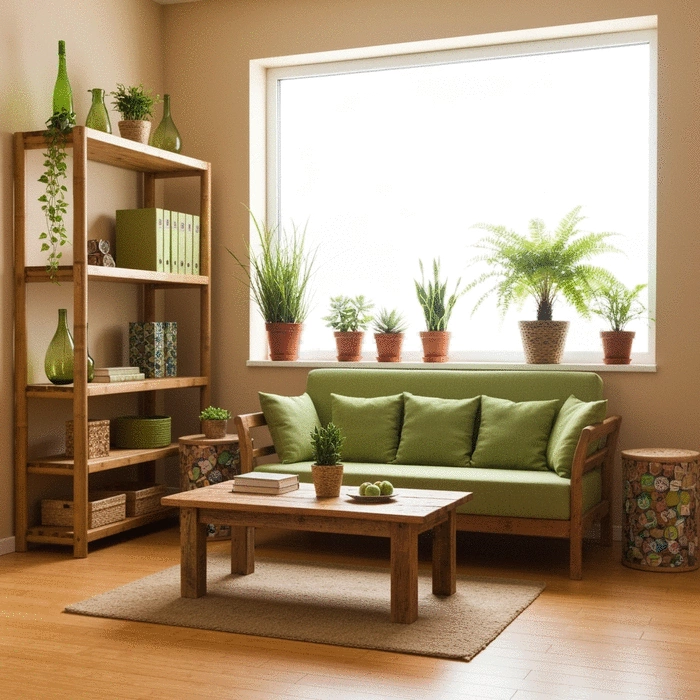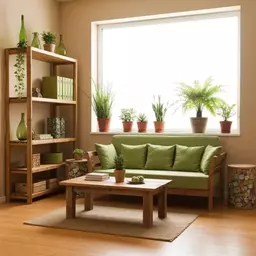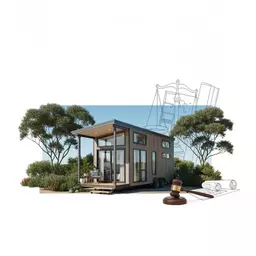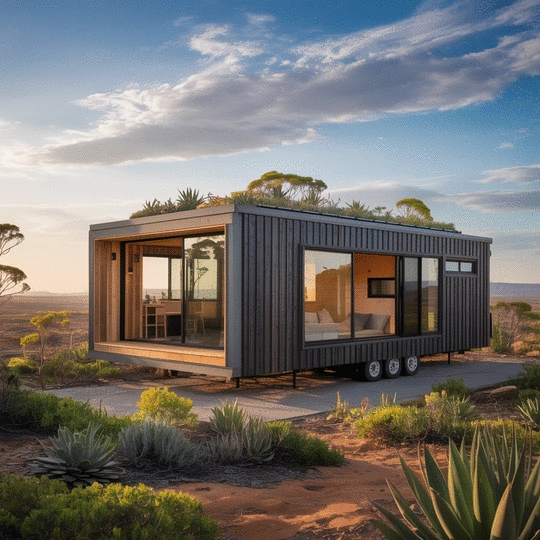Sustainable Design for Small Spaces

Posted on: 2025-10-30
By: Sophie Marchant
What if your small living space could also be a sanctuary for the planet? Embracing sustainability not only enhances your home but also serves our environment. By making conscious design choices, you can create a beautiful and eco-friendly living space that reflects your values.
What You Will Learn
- Understanding the benefits of eco-friendly design, including reduced environmental impact and improved indoor air quality.
- Core principles of sustainable design in small spaces, such as using recycled materials and adopting a minimalist approach.
- How to incorporate biophilic design elements, like natural materials and indoor plants, to enhance your well-being.
- Effective strategies for maximizing natural light to create a more inviting and sustainable atmosphere.
- Tips for overcoming common challenges in eco-friendly small space design, including sourcing durable materials and staying within budget.
- Budget-friendly options for sourcing eco-friendly materials and furniture, like shopping at thrift stores and considering DIY projects.
- Inspiring real-life examples of successful eco-friendly small space designs that demonstrate innovative practices.
- The importance of adopting sustainable habits that complement your eco-friendly home and contribute to a greener community.
Benefits of Eco-Friendly Design in Small Living Spaces
Here are the key advantages of eco-friendly design for small living spaces, which can significantly impact both the environment and personal well-being. To discover more about making informed choices for your home, consider choosing your ideal tiny home.
Reduced Environmental Impact
Sustainable choices minimize pollution and conserve natural resources, leading to a healthier planet.
Improved Health
Eco-friendly materials often have fewer toxins, leading to better indoor air quality and healthier living spaces.
Cost Efficiency
Energy-efficient designs can lower utility bills, saving you money in the long run and making living sustainable financially viable.
Minimalist Approach
Keeping clutter to a minimum encourages mindful consumption and reduces waste in small living spaces.
Embracing Sustainability in Small Living Spaces
In a world that's becoming increasingly aware of our environmental impact, embracing sustainability in small living spaces is more important than ever! By prioritizing eco-friendly design choices, we can significantly reduce our carbon footprint and enhance our well-being. Just think about it—living sustainably not only benefits the environment but also leads to healthier indoor spaces. When we incorporate sustainable practices, we create harmony with nature in our homes.
Additionally, choosing sustainable options can also lead to cost savings in the long run! By focusing on eco-friendly practices, we minimize waste and energy consumption, making our small living spaces both efficient and economical. So, whether you're a long-time tiny living enthusiast or just starting your journey, there are so many advantages to embracing this lifestyle.
Understanding the Benefits of Eco-Friendly Design
Eco-friendly design is all about making choices that prioritize our planet while enhancing our living environments. The benefits are numerous, particularly for those of us in tiny homes. Firstly, using sustainable materials helps reduce resource consumption and waste. Here are a few key advantages:
- Reduced Environmental Impact: Sustainable choices minimize pollution and conserve natural resources.
- Improved Health: Eco-friendly materials often have fewer toxins, leading to better indoor air quality.
- Cost Efficiency: Energy-efficient designs can lower utility bills, saving you money in the long run.
Remember, each choice we make can have a ripple effect on the environment, especially in a tiny home where every detail matters! Embracing sustainability is not just a trend; it's a lifestyle shift that fosters a healthier planet and healthier living. For more insights on how to live sustainably, check out our guide on sustainable living in tiny homes.
Defining Eco-Friendly Design Ideas for Small Spaces
When we talk about eco-friendly design, we're referring to practices that prioritize sustainability, functionality, and aesthetics—especially important in small spaces. It encompasses a variety of methods, focusing on using sustainable materials and maximizing efficiency. Here are some core principles of eco-friendly design in tiny homes:
- Use of Recycled Materials: Incorporating recycled wood, metal, or glass can add character while being kinder to the planet.
- Minimalist Approach: Keeping clutter to a minimum not only saves space but also encourages mindful consumption.
- Energy Efficiency: Choosing appliances and lighting that consume less energy contributes to a sustainable lifestyle.
As you consider your design options, think about how each element can enhance your living space while also respecting our environment. At The Tiny Living Guide, we love exploring these eco-friendly choices that transform small areas into vibrant, sustainable homes!
Exploring Biophilic Design in Small Spaces
Biophilic design is an innovative approach that integrates nature into our living environments, which can be particularly beneficial in small spaces. By connecting with nature, we enhance our well-being and create a soothing atmosphere. Here are some ways to incorporate biophilic design in tiny homes:
- Natural Materials: Use wood, stone, and other organic materials to create a warm and inviting feel.
- Large Windows: Maximizing natural light and views not only makes spaces feel larger but also connects us with the outdoors.
- Indoor Plants: Adding greenery improves air quality while bringing a touch of nature indoors.
Imagine waking up in a cozy nook surrounded by natural elements—it’s a dream worth pursuing! At The Tiny Living Guide, we believe that biophilic design can truly elevate our tiny living experiences and inspire a deeper connection to the world around us.
Maximizing Natural Light for a Sustainable Atmosphere
Natural light is one of the most valuable resources we can harness in small living spaces! Not only does it make areas feel more spacious, but it also has a positive impact on mood and well-being. As we dive into maximizing natural light, it's essential to consider some effective techniques to brighten up our tiny homes.
By incorporating these strategies, you can create a warm and inviting environment that enhances your sustainable living experience. Let’s look at some actionable tips!
Quick Summary
Here's a brief recap of the key points discussed so far:
- Embracing sustainability in small living spaces not only benefits the environment but also enhances indoor well-being.
- Eco-friendly design reduces pollution, improves health, and leads to cost savings.
- Incorporating biophilic design elements can connect us to nature and enhance our living environments.
- Maximizing natural light is essential for creating a sustainable atmosphere in tiny homes.
- Sourcing local materials supports community and sustainability while enhancing your design.
Addressing Common Challenges in Eco-Friendly Small Space Design
When diving into eco-friendly small space design, you might face some common challenges. Questions often arise about sustainable choices, maintenance of materials, and how to keep it all within budget. At The Tiny Living Guide, we’ve gathered insights to help you navigate these concerns while creating your dream tiny home!
One of the most frequent questions I encounter is about the durability of sustainable materials. Many assume that eco-friendly options are less sturdy than traditional ones, but that’s a myth! In fact, materials like bamboo and reclaimed wood can be incredibly resilient and beautiful, making them perfect for small spaces. Find more tips on selecting materials for tiny homes to ensure durability and sustainability.
- What sustainable materials are best for small spaces?
- How do I maintain eco-friendly furniture and finishes?
- Can I find budget-friendly sustainable options?
Tips for Budget-Friendly Eco-Friendly Design Options
Creating a sustainable living space doesn’t have to break the bank! There are plenty of ways to source affordable eco-friendly materials and furniture without sacrificing quality. Here are some actionable tips that I've found helpful:
- Shop at local thrift stores or second-hand shops for unique finds.
- Look for sales on sustainable brands that prioritize eco-friendly manufacturing.
- Consider DIY projects using reclaimed materials; there are countless tutorials available!
- Join community groups or forums focusing on sustainable living for shared resources.
By being resourceful and creative, you can achieve a stylish, eco-friendly small space that reflects your values and keeps your budget in check!
Real-Life Examples of Successful Eco-Friendly Small Space Designs
Seeing is believing! Let’s take a peek at a few inspiring case studies that showcase the beauty of eco-friendly design in small spaces. These real-life examples demonstrate how innovative design can lead to functional and sustainable living environments.
- A tiny home in Australia that features upcycled materials for furniture and decor, creating a cozy yet stylish atmosphere.
- A compact apartment designed with energy-efficient appliances and smart technology to minimize energy use.
- A small studio that incorporates vertical gardens to enhance air quality and add a fresh, vibrant touch.
These transformations not only reflect the power of eco-friendly design but also emphasize the endless possibilities that come with small living spaces!
Inspiration from Local Sources: Sourcing Eco-Friendly Materials
As someone who values community support and sustainable practices, I encourage you to explore local vendors for your eco-friendly materials. Not only does this help the environment, but it also strengthens our local economy! Here are a few ideas on where to look:
- Local farmers' markets or craft fairs for handmade items.
- Community workshops focused on sustainable building and design.
- Reclaimed lumber yards that specialize in salvaged materials.
By sourcing locally, you not only find unique products but also connect with artisans and businesses that share your commitment to sustainability.
Showcasing Tiny Homes as Sustainable Living Solutions
Tiny homes are the epitome of efficient use of space, and they are designed with sustainability in mind. They often utilize innovative materials and energy-saving technologies, making them perfect examples for anyone interested in eco-friendly living. Have you ever thought about how a tiny home could transform your lifestyle? Here are some key features:
- Smart design that maximizes every square meter.
- Integration of sustainable practices, such as rainwater harvesting and solar panels.
- Use of natural materials that are both durable and aesthetically pleasing.
At The Tiny Living Guide, we believe tiny homes can serve as a blueprint for sustainable living, providing a wonderful blend of comfort and eco-friendliness!
Encouraging a Sustainable Lifestyle in Small Spaces
Beyond the design choices you make, adopting sustainable habits can truly enhance your small living experience. Simple lifestyle changes can complement your eco-friendly home, making a significant impact on the environment.
- Practice recycling and composting to reduce waste.
- Be mindful of your consumption and choose items with minimal packaging.
- Engage with your community through local initiatives focused on sustainability.
By embracing these habits, you not only support your eco-friendly design efforts but also foster a culture of sustainability among those around you! For more comprehensive guidance, explore additional resources on sustainable living practices.
Wrapping Up: The Importance of Sustainable Choices
As we wrap up, remember that every small choice counts when it comes to sustainability. By integrating eco-friendly design ideas into your small living space, you’re not just enhancing your home; you’re also contributing to a healthier planet. Let’s all take steps toward creating spaces that reflect our values and aspirations!
Call to Action: Start Your Eco-Friendly Design Journey
Are you feeling inspired to embark on your eco-friendly design journey? I encourage you to implement the ideas discussed here and share your transformations with our community at The Tiny Living Guide. Together, we can celebrate the beauty of sustainable living in small spaces. Let's get started on this incredible journey together!
Frequently Asked Questions (FAQs)
- What are the main benefits of eco-friendly design in small living spaces?
- Eco-friendly design offers numerous benefits, including reduced environmental impact, improved indoor air quality due to fewer toxins in materials, and cost efficiency through lower utility bills from energy-efficient designs. It also promotes a minimalist approach, reducing waste and encouraging mindful consumption.
- How can biophilic design be incorporated into small spaces?
- Biophilic design can be integrated by using natural materials like wood and stone, maximizing natural light with large windows, and introducing indoor plants to improve air quality and connect inhabitants with nature.
- What are some budget-friendly options for eco-friendly design?
- To design eco-friendly on a budget, consider shopping at local thrift stores and second-hand shops, looking for sales on sustainable brands, undertaking DIY projects with reclaimed materials, and joining community groups for shared resources and ideas.
- Why is maximizing natural light important in sustainable small space design?
- Maximizing natural light is crucial because it makes small areas feel more spacious, positively impacts mood and well-being, and reduces the need for artificial lighting, thereby saving energy and contributing to a sustainable atmosphere.
- How do tiny homes exemplify sustainable living solutions?
- Tiny homes are designed with efficiency and sustainability in mind. They feature smart designs that maximize every square meter, integrate sustainable practices like rainwater harvesting and solar panels, and use durable and aesthetically pleasing natural materials, serving as a blueprint for eco-friendly living.
Recap of Key Points
Here is a quick recap of the important points discussed in the article:
- Embrace Sustainability: Prioritize eco-friendly design choices to reduce your carbon footprint and enhance indoor well-being.
- Eco-Friendly Design Benefits: Sustainable materials improve health, lower utility bills, and reduce environmental impact.
- Core Principles: Use recycled materials, maintain a minimalist approach, and focus on energy efficiency in small spaces.
- Incorporate Biophilic Design: Utilize natural materials, maximize natural light, and include indoor plants to connect with nature.
- Budget-Friendly Options: Seek local thrift stores, consider DIY projects, and explore community resources for sustainable materials.
- Community Support: Sourcing materials locally not only promotes sustainability but also strengthens local economies.
- Adopt Sustainable Habits: Engage in recycling, mindful consumption, and community initiatives to complement your eco-friendly living space.
 What if your small living space could also be a sanctuary for the planet? Embracing sustainability n
What if your small living space could also be a sanctuary for the planet? Embracing sustainability n
 As the tiny home movement gains momentum in Australia, the legal landscape can feel daunting. Howeve
As the tiny home movement gains momentum in Australia, the legal landscape can feel daunting. Howeve
 Did you know that zoning laws can significantly impact the feasibility of sustainable housing initia
Did you know that zoning laws can significantly impact the feasibility of sustainable housing initia
